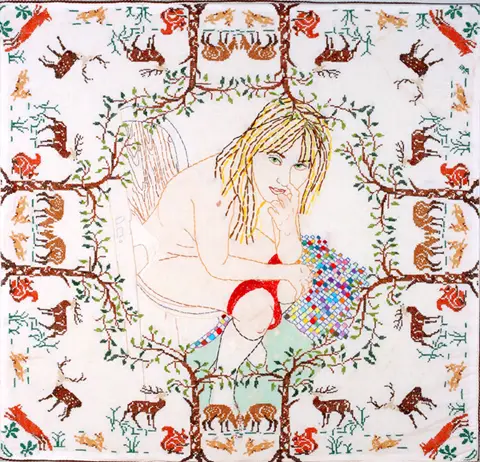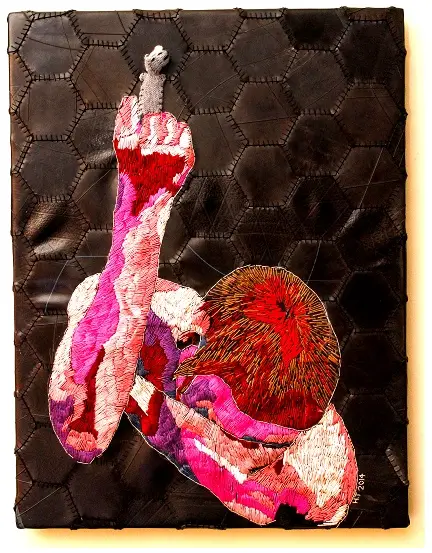Every year, Hand & Lock organizes a competition for the prestigious Prize for Embroidery to promote the use of hand embroidery in fashion and to discover emerging embroidery talent. The 2015 brief was about the individual design identities of Countries.
On Thursday, the 5th of November, London’s Bishopsgate Institute hosted the final of the 2015 Hand & Lock Prize for Embroidery.
Today we’ll meet the first place winner in the Open Category.
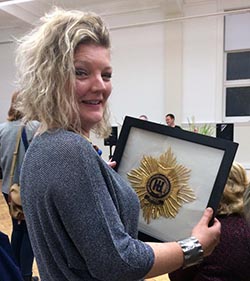
Name: Jacky Puzey
Location: Bristol, UK
Jacky, I’m inclined to call you a Bespoke Embroidery and Tailoring Artist. Does that work, or do you prefer another title?
Sounds good to me! My embroidery business is called Jacky Puzey Embroidery and Tailoring Commissions. My background in Fine Art, combined with my obsession with fashion, performance and embroidery, definitely fits your description!
Describe your Nigerian Riot Girl Hand & Lock entry:
So, this is what I did and my research for the Nigerian Riot Girl!
My brief: Feral lace and fashion activism;
‘Culture does not make people. People make Culture.’ Chimamanda Ngozi Adichie, Writer.
I wanted to create a Nigerian riot girl, a strong activist, both glamorous and able to fight back within her communities. Her elaborate lace outfit is created from a cocktail of embroidered oil spills, traditional Adire and Hausa motifs and stories and creatures that resist. The hyena, no longer muzzled, can transform into a witch; I used real fur and intricate embroidery to create a sense that the embroidery too might come alive. The crocodiles can live on both water and land, and are both feared and revered. The grey parrot is one of the five birds in the Yoruba Ife creation mythology; its tail is bright red because the gods allowed it to dip its feathers in bright red palm oil, and this myth in turn reflected and inspired the development of dye technologies in Yoruba culture. My parrot, built from real feathers, red paint and laser cuts, flies in a streak of red across the dress.
My Nigerian riot girl is also inspired by the ambiguous activism and street fashion glamour of M.I.A., from Paper Planes visas to desert swagger; and the rich gothic patterns created by Jake and Dinos Chapman for Louis Vuitton. Her look is a costume of opulence, resistance and renegotiation; it’s a couture feral lace, with the level of detail of the most expensive Swiss Lace embroidery, but some threads that also show in the dark, since those without money in Nigeria usually have no access to electricity. The mask replaces the head wrap and the hijab, its structure echoing the Yoruba head wraps and the veils worn by Hausa women, but refuses allegiance to any oppressive traditions. The trousers are pleated and designed like the men’s’ Agbada robe trousers, rather than women’s trousers. Deliberately her look is a spectacular activism; dressing to pass across Nigeria’s many interlinking cultures, while fashioning new identities for a future where the Chibok girls will always be able to escape . . .
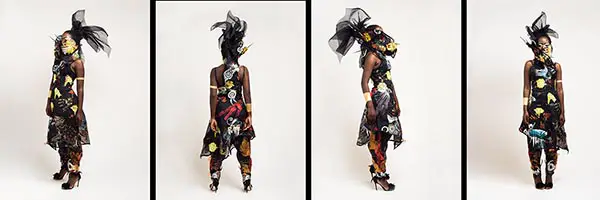
What made you want to enter this competition?
I’ve followed the competition for a few years, and in 2014 was lucky enough to visit Hand & Lock’s studios, where I was able to show some embroidery samples to Jessica Jane Pile, their brilliant production manager; she encouraged me to enter the competition.
What motivated your choice for your entry? Why did you choose Nigeria?
I loved the brief—I’ve done a lot of research into postcolonial fashions and the performance of fashion across cultures. I’ve also lived in Sierra Leone and Cameroon, West Africa, across West Africa, and many other countries. The reputation of Lagos, Nigeria, looms large as an incredibly creative and fashion-obsessed place, and at the same time an edgy, vibrant, hustling African megacity.
I’d also been looking at the photos of South African photographer Pieter Hugo, specifically his Hyenas and Other Men series. I also researched African Lace fabrics and the resurgence in contemporary fashion designers in Lagos creating outfits that re-evaluate more traditional cloths such as indigo dyeing and Hausa embroidery. There’s also the Comic Republic, creating Nigerian superheroes.
I started my research with the colonial beginnings of Nigeria, a vast country that was not originally created by its inhabitants but by its British colonial masters to exploit for resources. It has become the largest state in West Africa since independence in 1960, both in geography and reputation. Nigerians have long sophisticated histories of textiles and arts cultures, from Yoruba Adire indigo dyeing, to Hausa hand embroidery, to the heavily embroidered Laces that create contemporary wedding, church, and occasion dresses. Nigeria is currently infamous abroad for corruption, scams, and missing oil money; for vast wealth, great poverty and political coups; for religious conflict and the pollution of the Niger Delta oil production; held up as an example of ‘African’ corruption and chaos. But, as author Chimamanda Ngozi Adichie has pointed out, there is a great danger in taking a single story; because then the teller of that story has claimed all the power for their version of events, and both colonial and current elites have exploited Nigeria.
Deliberately, the Nigeria I looked at is full of diverse stories of resistance, of cultural negotiation and exchange. #BringBackOurGirls, about the kidnapping of the Chibok Girls by Boko Haram, has become one of the longest running and most successful twitter campaigns across Nigerian communities and international supporters, mobilizing a feminist activist space in a patriarchal country. Hellish landscapes of oil explosions and resource pillage sit side by side with a thriving contemporary fashion scene, for example Lagos luxury brand Tiffany Amber, and now more activist fashion from Maki Oh, reworking traditional textiles. The nomadic Gadawan Kura, or hyena handlers, prowl the streets of Lagos and Abuja, entertaining crowds with ‘wild’ animal displays, while luxury cars sit still in Lagos’ infamous ‘go-slows’, traffic jams. Nollywood films use Hollywood gangster storylines and mobile phone exchange rom-coms equally with indigenous Nigerian mythology about gods, monsters, possession and witchcraft, actors frozen in a postcolonial fusion of modernity and tradition in Pieter Hugo’s Nollywood portraits. Slum dwellers in the floating coastal slums of Makoko (Lagos) and Port Harcourt, fight back with self organizing fluid communities, working with contemporary architects to make floating schools and radio stations to reclaim their place. Tradition, culture and contemporary business are all fast moving and fluid within a country both conservative and incredibly inventive.

Who was your mentor, and how did s/he help with your project?
My mentor Aimee Betts was really helpful—she helped me in editing the designs, we talked a lot about placement and the overall impact of the outfit, we made some great mood boards, which I’d never had to do before, preferring the artist big fat sketchbook of masses of research and drawing.
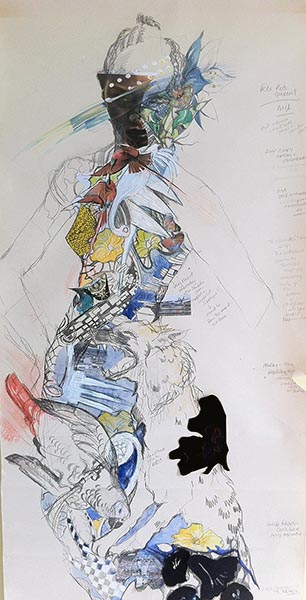
Are there any secrets you can now reveal about your entry?
Some of it shows up in the dark . . . (Lumy threads) the concept was to provide a glamorous dress that might also be useful to a Riot Girl, as some of it can be seen by her followers while she is out on her activist missions. Electric power is pretty intermittent in Lagos unless you are rich.
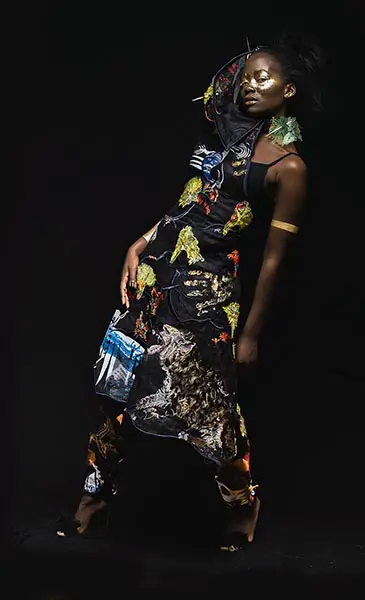
There are a lot of embroidered motifs on the Nigerian Riot Girl outfit. (You called it an “outfit” on your website, so that’s what I’m calling it, but I confess that word feels inadequate.) Name three favorite motifs, and tell us why they’re your favorites. The hyena tops my list, but I’ve gotten a good view of only a handful. We need more pictures!
The Hyena is my favourite too! He/She started it all. I’d been looking at the series The Hyena and Other Men, by South African photographer Pieter Hugo, and was struck by how much his images conveyed both about the relationship between both ‘handler’ and hyena, and their joint perceived outsider status; the Gadawan Kura, or Hyena Men, live on the edges of many West African cities as nomadic ‘entertainers’. But, as I looked at Nigerian mythology, it transpires the hyena is able to transform into a witch at will, and I wanted to reinvent my hyena as a feminist activist then, unmuzzled, able to transform, and a willing participant in the Nigerian Riot Girl story. The textures and energy of the embroidery are created by keeping a lot of my original drawing elements, and combining them with dense embroidery and real (goat!) fur in contrast to the cotton organdie backing.
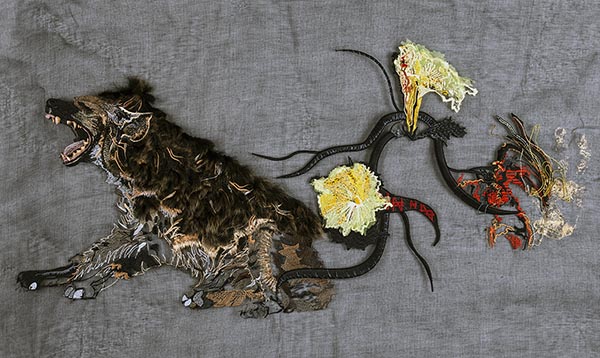
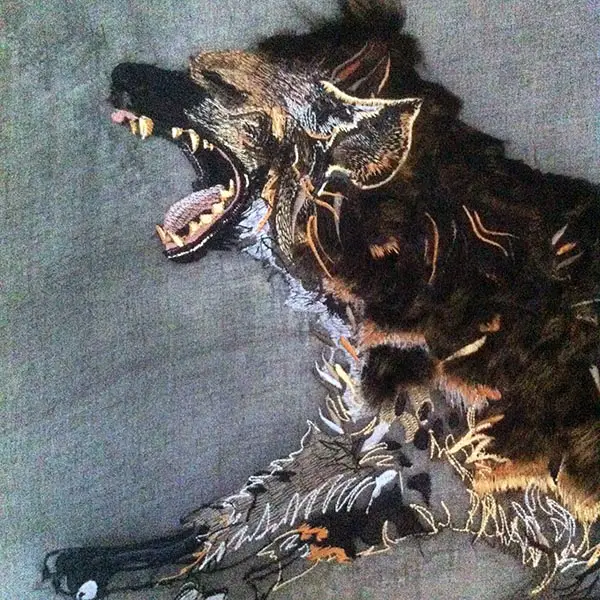
The oil flowers and thick rivers flowing over the dress: So, when I was researching the outfit again, I wanted to use the floral motifs so common in a lot of African Lace fabrics (Swiss Lace, also known as). But I wanted to make my own, and to make them a lot more edgy. So, I had the flower fabrics all laser cut from my own drawings of the Nigerian national flower, Costus Spectabilis, in both transparent shiny fabrics and African wax print cotton; the transparent fabrics gave the cotton a kind of oily sheen, which started me on the connecting design of river delta patterns and oil spills. Suddenly the flowers had transformed into the notorious oil flares of the Niger Delta, signaling yet another spill, flaring up from the dark oil-contaminated waters . . . aerial views of serious oil spills are often called oil flowers . . . it’s quite an extraordinary contrast of something benign like a flower linked with the poisonous contamination of communities and landscapes across the Niger Delta. I wanted to subtly evoke the contradictions in current postcolonial Nigeria, of oil riches and massive exploitation and damage.
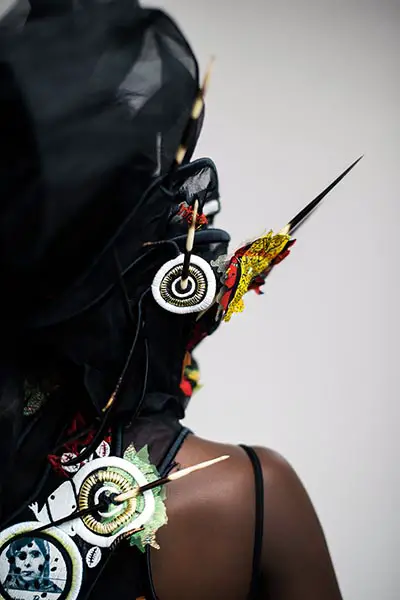
The print and traditional embroidery motifs: the large white and printed patterns running down the back and front of the dress and some of the hem. In Nigerian Yoruba culture, there is a long tradition of indigo dyeing, with both tied and stitched patterns and starch resists being used. Chief Nike Davies-Okundaye is spearheading a one-woman revival of the awareness of Adire. I particularly looked at the stenciled starch resist Adire Eleko patterns, where each pattern carries a specific meaning; originally I wanted to use the Jubilee cloth images, a pattern derived from both Nigerian and British colonial coronations. However, I wanted to embroider rather than print, to create a new contemporary texture while still paying homage to the Adire tradition. So I created my own drawings based on those prints, to create embroidery motifs, that I then printed over using heat transfer printing, using images of contemporary Nigerian cities. I then also began to interweave motifs from the traditional Hausa Muslim embroidery into these designs. A lot of the Hausa embroidery is done by women in seclusion at home; it provides an income being able to work at home, but can make the embroiderers vulnerable to being ripped off by the middlemen sellers. This embroidery was very much about interrogating the idea of traditions and feminism, since it was about adapting ‘traditional’ embroidery and motifs for a Nigerian Riot Girl to wear.
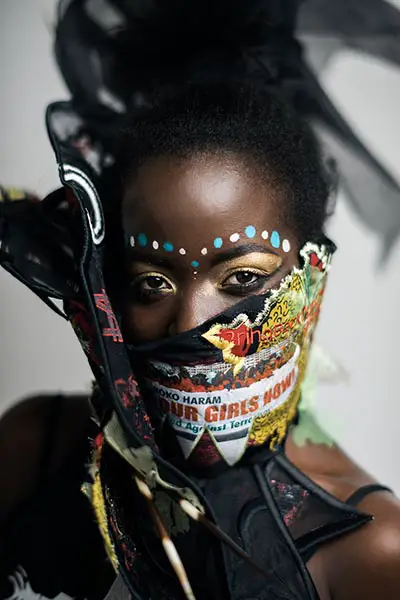
Tell us about your education background and how it led you to where you are.
I did a Fine Art BA at Sheffield Hallam University, where I got into carnival costume via a work placement at London’s Notting Hill Carnival.
After that I went off and worked as an arts/exhibitions organizer for a while, then I started an MA in Visual Culture (Theory) at Bath Spa University.
I had a break in which I joined sewing and pattern cutting classes at Silai for Skills in Bristol (an amazing culturally diverse sewing school for women), and came back with more cutting skills and a growing obsession with textiles and postcolonial culture.
I finished the MA in Visual Culture Fine Art with an installation called Postcolonial Dreamcoats. Then I was on a bit of a roll and did my practice-led PhD in postcolonial fashion and performance across cultures. I produced a big project called Shade, using bespoke embroidered suits and performances incorporating parades, dinners and space to share stories, embellished or not: it was kind of about tailoring across cultures. Because everyone can engage with dress and food; the embellished suits created a space of embroidered stories too.
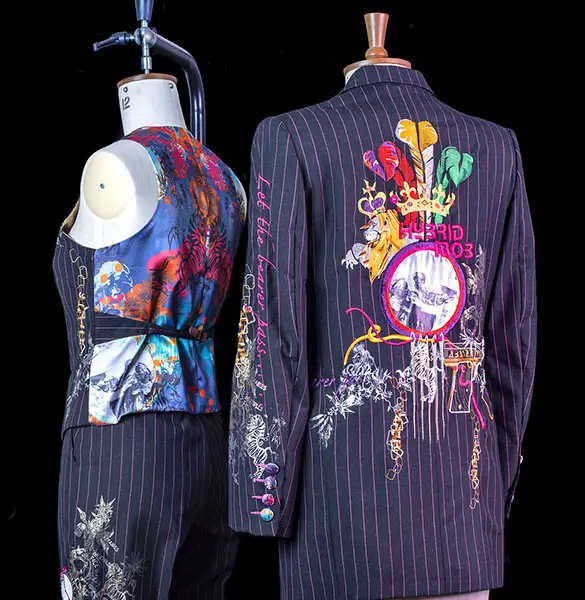
My Shade project is about influence and exchange. Beautifully tailored suits act as passports, getting you into places that you might not otherwise expect. It starts from my memories of travelling the business circuit from England to Europe, USA and Africa when I was growing up, where invitations and image meant a lot on the diplomatic social circuit, but it also considers dressing to move countries, to migrate, to arrive in new cities, to create a passport into new communities and the rules of those passports.
It’s also about creating ‘shade’, a slang term from Trinidadian Carnival, meaning to make such a fabulous costume that everyone else is literally in your shade, under your influence. In a world of globalised business, it’s also about the unwritten influences and traditions in the suit itself, having the right suit, being part of the networks of cash and economic exchange, and how you access those, the human cost of migration and aspiration. Shade suits bear their allegiances and influences embroidered on their sleeves, rather than subtly hidden in social codes and exclusive invitations, and become a carnival cartel, exposing the deeply traditional codes inherent in the fabric of the suits as the wearers do business with themselves and their audience.
You can see these suits on my website.
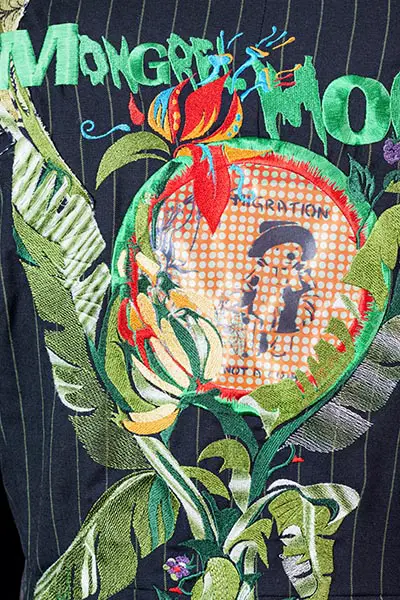
When and how did you learn embroidery? Have you ever done hand embroidery?
I have done some hand embroidery at school and with my Mum, and lots of free machine embroidery, and some experimental hand additions! But embroidery really took off for me at the start of my PhD, when I discovered how I could really use embroidery to express my ideas, through the big digital embroidery machine at Bath Spa University. I love both the precision, and the potential for amazing experiments on the digital embroidery machine as it stitches through many different kinds of materials. I pause it for all sorts of additions and manipulations to the embroidery, such as feathers—and wallpapers and leathers. I programme all the stitches I want.
I’m also very excited about what’s on offer through the Hand & Lock competition win—I’m going to learn tambour beading and gold-work, as it will be great to explore more skills and start incorporating different kinds of handiwork into my embroideries, which will then also feed into developments with the digital embroidery.
What was your first embroidery project?
My first big commissioned embroidery project was a gorgeous tweed jacket for a client who wanted to wear most of the things she loved in her garden.
She’d seen all the Shade suits I made for my PhD, tailored suits embellished with their own particular passports, and wanted to work with me to translate the concept into a jacket for her as a New Zealander living in England and creating a garden of plants from UK and New Zealand. She brought me lists of birds, animals and plants she loved, and I got drawing and designing!
Have you ever had an embroidery disaster? If so, spill!
Last year I worked on a giant embroidered Tapestry with artist Laura Kriefman; she had a great commission to re-vision the Sheldon Tapestry held at Warwick Museum for the 21st C, complete with embroidered space travel, the human genome, etc.
Two days before completion, my embroidery machine went pop!! Turns out an electrical surge had caused the main control panel to blow. Thank God for business insurance!!!
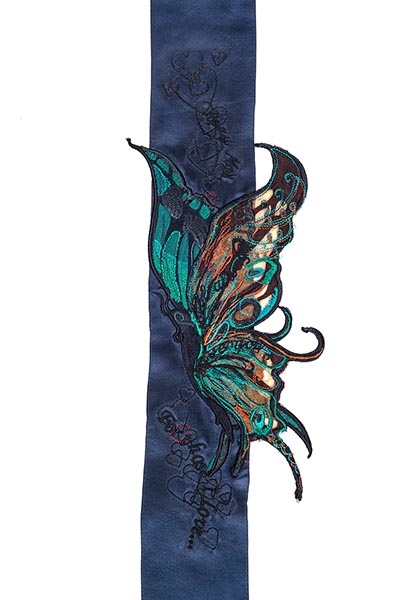
What’s been the biggest surprise of your career and the projects you’ve undertaken?
It’s been amazing just how many brilliant projects I can be involved in with digital embroidery! Just this year, I’ve worked on a range of embroidered tattoo patches and wallpaper based on a local tattoo archive. Then there was the Sheldon Tapestry for Warwick as above; a range of embroidered electrical toys for a sensory healthcare design project; a series of large screens of feathered turtledoves and a range of cushions for a retail brand focusing on endangered wildlife ; and a collaboration with designer Sadie Clayton on her SS2016 collection with an amazing 3D bomber jacket and other pieces.
And of course I developed my own work and all sorts of new areas to explore with that ‘outfit’ for Hand and Lock 2015.
What projects are on the horizon for you?
I’m just about to start the Crafts Council’s Hothouse scheme, very excited about that as it is 6 months’ intensive business development and lots of new contacts! And I have a whole urban feral creature embroidery project in my head; just need to carve out the time to make it!
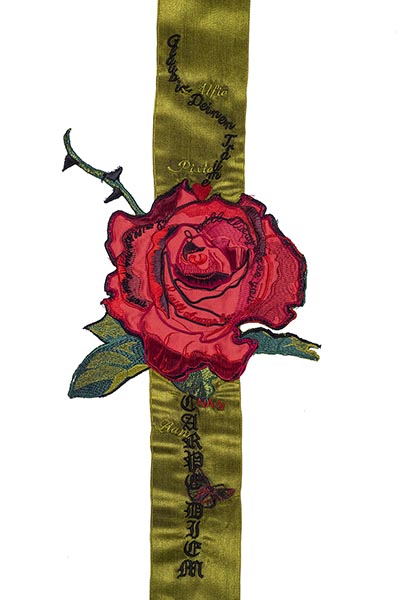
Where else can we see your work?
You can visit my website, and follow me on Facebook, Twitter, Instagram etc . . . a lot of my commissions are in private ownership. I can also be found on the Crafts Council’s Directory of Makers.
Currently my Hand & Lock outfit is in the window at Hand & Lock London which is exciting!
Describe your dream commission. What and for whom is it?
Someone lets me into a National Trust house full of amazing treasures (or English Heritage, or whoever might have such a house, not fussy!) and I have the space and funding to make a whole room of embroidered wallpapers and creatures, and an outfit to wear in it. I love that embroidery is about embellishing stories . . . new layers of textures and fabrics being added to old spaces and histories . . .
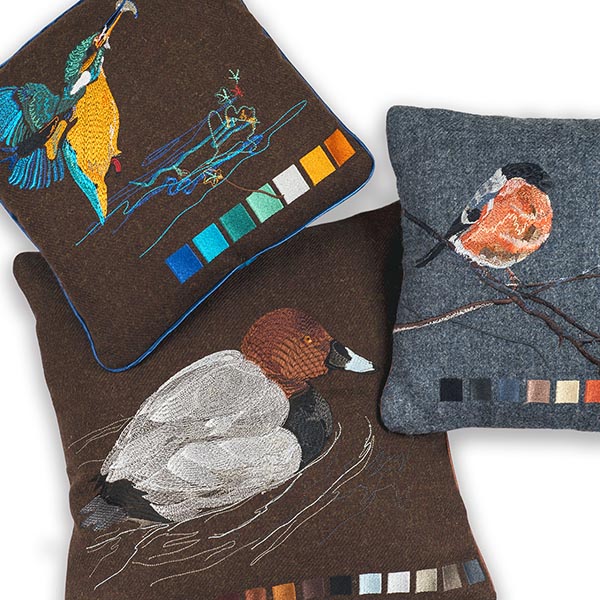
Rapid-fire Round: (Don’t think too hard about these.)
If you could embroider with just one color thread for the next three years, what would it be? Madeira 1244—can’t get enough of that magic deep navy!
What stitchable motif would you choose to represent you and your life? Currently a fox with a rather splendid embellished coat and tail, armed with a passport to migrate wherever she chooses. There is some brilliant graffiti in Easton, Bristol, where I live; it’s an image of Paddington Bear with a suitcase saying ‘migration is not a crime’.
You’re asked to create a garment for an animal. What is the animal, and what do you create? Well, funny you should ask that: currently I have a pet (taxidermy-ied!) squirrel in my studio and he is going to be fully re-fur-bished in embroidery. He led a long and full life, he came from an East London park via a brilliant vegetarian taxidermist, my friend Loz at Callous Creations, and he’s going to get a new fur robe with a much better tail, and an embroidered scene to live in; urban feral parklife and the ‘invasion’ of the grey squirrels will be his riff
Favorite book you’ve read recently: the catalogue for the Fabric of India exhibition at the V&A.
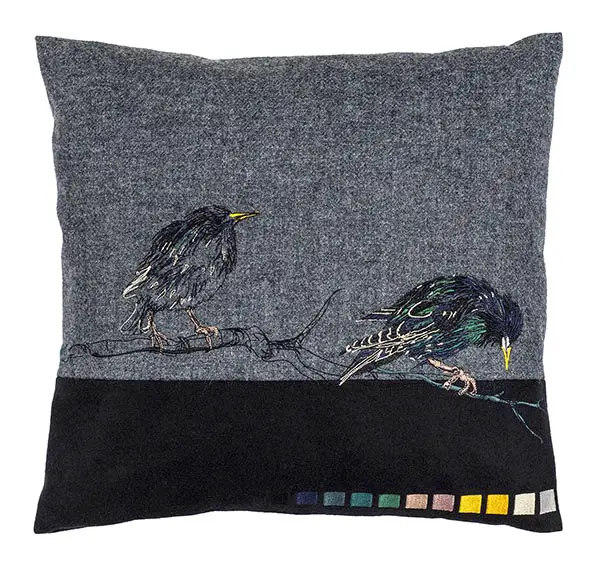
You must include something edible in your next garment. What do you use, and how do you incorporate it? Pomegranate seeds—the juice would stain all the threads around it, they dry up and rot beautifully, and they would look from a distance either like scarring or like shiny crystals.
If you were not an artist, what would you be? I would have my own eccentric museum . . . ! Or be a fashion designer. An archaeologist would be fun too! Or a diver; love swimming and all things watery . . .
You must turn a song into a garment. What’s the song, and what’s the garment? Mack the Knife sung by Ella Fitzgerald (which was pretty much an improv version!) and the garment is a tweed suit where the tweed becomes so heavily embroidered with scars, new tweed patterns, and embellishment that it becomes a living record of night walking, dark urban areas, and most importantly, an iconic urban dandy in a disreputable suit embellished with traces of misdeeds . . . I once read a quote by John Waters the filmmaker where he talked about going on riots and protests with his ‘favourite riot date’ who would dress up in full Jean Harlow drag to riot . . . love that image! I also once made a suit with special ‘poaching’ pockets in the lining to conceal things ‘acquired’ . . . for art, NOT for criminal intent I hasten to add! 😉
Favorite place you’ve visited: At the moment, Lisbon. A few years ago, Japan. Many years ago, Kenya. When I was little, Panama was cool too!
A celebrity wears one of your garments to an awards show, and you receive fame, fortune, good health, fitness, and cake for life. Who is the celebrity and what does s/he wear? Grace Jones and she wears an amazing tailored suit, combining the flare and motifs of the Shade suits, with elements of the 3D bomber jacket that I did for Sadie Clayton SS2016, as a tailored disco outfit!
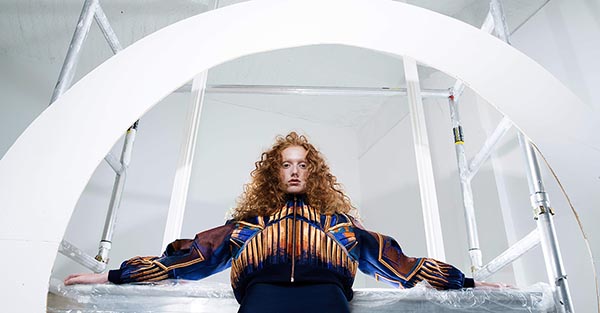
Photos Ki Price
We’re hosting a show of “performance embroidery.” Describe your piece in the event. Ahem well, not an embroidered riot despite my Nigerian Riot Girl and suggested Mack the Knife suit above!! Hmmm well I love collaborating and working on the digital embroidery machine, so maybe I work with the audience to create new slogans and images from their suggestions, to create a giant banner at the end of the day to use for future embroidery campaigning . . . kind of like a banner for an unholy trades union alliance of activist stitchers.
Jacky, this has been a heap of fun. Thanks for taking the time to e-talk with us! We look forward to watching your career.



